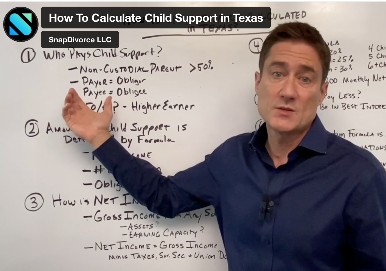
How The Divorce Process Works In Pennsylvania: Choose Your Own Adventure
Most people thinking about getting divorced have no idea how the process works. In this week’s Divorce Academy video, Kevin gives an overview of how the divorce process works in Pennsylvania, and compares the traditional divorce litigation process with SnapDivorce’s mediation process.
.
Video Transcript:
Hey everyone, welcome to Divorce Academy.
In today’s video we’re going to talk about how the divorce process works in Pennsylvania. I’m going to give you a very broad overview of the process. A 20,000-foot view. I can’t get into all the details.
A lot of people come to my office and have no clue how the divorce process works. They don’t know where to start. Really, they’re blind to the whole process. So, this video is meant to answer your basic questions about how the process is going to go.
I’ve broken it down to two categories: Litigation and Mediation.
Litigation is really what you think about when most lay people think about divorce – lawyers, courts, etc. And mediation is really a private way to get divorced.
With litigation, I subtitled it “Choose Your Own Misadventure.” The reason I did that is because litigation in divorce is really like those “Choose Your Own Adventure” books that you read as a kid. Once you go down one path, it leads to other paths, and it really can go any which way. So, it’s impossible for me or anyone else to tell you how your case in particular is going to go. It could last years. It could be quick. It could have lots of issues. It really just depends on your particular situation.
However, there are common elements to all divorce case and how the divorce process works. That’s what I’m going to cover.
I’ve broken the divorce process down into six steps.
The first step is “decide to divorce.” That seems like kind of an obvious step. But, it really is the first step in the divorce process. There are a lot of people who have been thinking about divorce and are not sure they want it. It’s that moment that you decide “Yes, I’m going to go for it. I want to get divorced.” That really is the first step and sends you down the path to divorce.
The next step is to file a divorce complaint. This is a piece of paper . . .actually several pieces of paper that you file with the court. In it you ask for divorce and you also have to raise any other claims that you would associate with divorce – property division, etc. And I’ve listed those claims here.
So, you’ve got Equitable Distribution, which is property divisions.
Special Relief, is kind of a catch-all. Could be that you need your spouse out of the house because you are not getting along well. Maybe you need a bank account frozen. Something like that.
Counsel Fees, Costs and Expenses.
Custody and Support. And those two have their own pathways. So, while your divorce is pending over here, if you raise those claims they’re going to have their own paths. For example, in custody you would have a custody conference, a custody evaluation, maybe a custody hearing.
You raise support, for example – Alimony, Alimony Pendente Lite (which is Alimony during the pendency of the divorce), child support – again that’s going to have another separate pathway. You’ll do a support conference, and you’ll have a support hearing.
So, Custody and Support can run independently, while you’re still trying to get your divorce done.
One thing I forgot to mention was . . . you file the Divorce Complaint in the county in which you reside. That’s true probably 99% of the time. So, if you reside in Montgomery County, then you’ll file your Divorce Complaint with the Court of Common Pleas of Montgomery County. If you live in Bucks County, then you’ll file with the Court of Common Pleas of Bucks County.
So, you decide to divorce. You get your Divorce Complaint together. You put the claims in it.
The next step is what’s called “establishing grounds for divorce.” What does that mean? It means you have to establish a legal basis for your divorce. It sounds complicated, but it’s actually pretty easy. In Pennsylvania there are several ways you can establish grounds for divorce.
The two big categories are fault divorce and no-fault divorce. Nobody really does fault divorce, so you can just forget about that.
With the no-fault divorce, there’s two sub-categories.
One is a consent divorce. That means you and your spouse agree to get divorced. You’ll sign papers called “Affidavits of Consent.” You file them with the Court. Once that’s done you can ask the Court to declare that you have ground for divorce. That can be done 90 days after filing and service of the Divorce Complaint.
The second way is to establish a one-year separation. Maybe your spouse won’t agree to a divorce. Then you have to wait one year from a date of separation. After that you can file a paper called an “Affidavit of One-Year Separation.” You file that with the Court. As long as your spouse doesn’t oppose it, you can get grounds for divorce.
Alright, so now you’ve got ground for divorce. You still have to resolve the claims you raised in your Divorce Complaint. You can do that a number of ways. You can litigate the claims. You can mediate the claims. You can resolve them over the kitchen table. You and your spouse can sit down, agree to custody, agree to property division. Maybe you get the house and Husband gets the horse. I actually had a case with six horses.
Once the claims are resolved, then whatever the decision or agreement is has to be memorialized. If you and your spouse don’t agree, then a judge is going to decide it for you. The judge will issue an order saying this is how the property is divided, this is how much support. If you and your spouse resolve it by agreement, then that has to be written up somehow. It can be written up into a contract or a Martial Settlement Agreement (“MSA”). Or, sometimes you go to court to a Master’s Hearing, and at the hearing, which is more like a settlement conference, you reach an agreement. Then a lot of times the Master will bring in a court reporter and the lawyers or the parties will just dictate to the court reporter what their agreement is. It actually happens quite frequently in divorce litigation.
So, once all that’s done; once you’ve got your ground and you’ve got your claims resolved, then you can get your divorce.
That’s sort of the overview of the divorce process in a nutshell.
Now, with mediation, we do it a little bit different here at SnapDivorce. In our mediation process the first thing we start with is identifying the issues in your case. Is there property that needs to be divided up? Are there support or custody issues?
So, we sit down with the couple. Trying to find out where they are. Decide what kind of issues they have in their case.
Once we figure out what issues there are, the next step we move to is to resolve the issues. We’re sort of kind of flipping it. Over here you start with filing the divorce complaint and proceeding with your claims. Over here we try and start with figuring out how we can best resolve the case.
Once we have identified the issues, we see if the parties are close. Can they resolve it themselves? Maybe we’ll send them home and see if they can talk it out.
If they can’t reach an agreement on some or all of the issues, then we schedule mediation sessions. Then we’ll sit down with the couple and try to figure out good solutions, offer suggestions, give them an idea of what the Court would do.
Almost all cases resolve either over the kitchen table or through some combination of mediation sessions and discussions. In the rare instance that the don’t resolve there, then we can arbitrate the issues, which means decide any outstanding issues like a judge. The parties have to agree to that.
So, once those issues are resolved, the next step is we draft a Martial Settlement Agreement. That is the written contract that memorializes your agreement. Send it to the couple. Maybe there are some revisions. Once that is completed, they sign the MSA and then we process the divorce. That is really easy at that point. Again, we do a 90-day consent divorce.
Finally, once the divorce is issued and the property settlement agreement is done, then we implement the agreement. And that can be anything from helping the parties sell their house to transferring retirement accounts. You might need something called a qualified domestic relations order, which allows you to transfer it tax-free. Things like that.
This process is really pretty simple.
So that is how the divorce process works in Pennsylvania in a nutshell. Hope this is helpful. We’ll see you next time on Divorce Academy. Thanks.
Related Articles

Don’t blow
everything for
the sake of
revenge.
Find out how SnapDivorce® can help you simplify your divorce.


